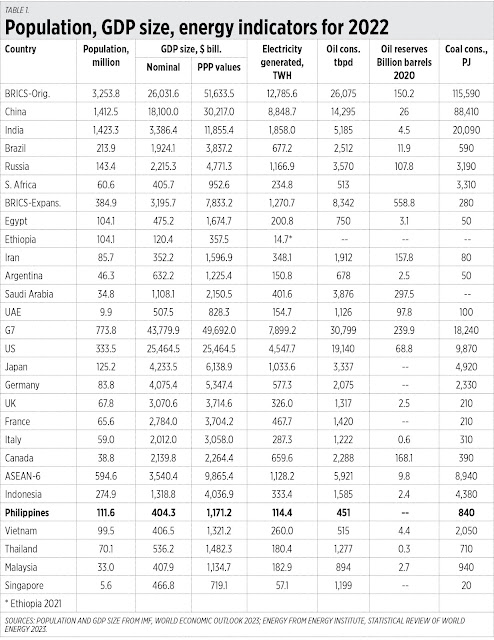BRICS energy and Philippine hosting of FIBA games
BRICS energy and Philippine hosting of FIBA games
August 29, 2023 | 12:02 am
My Cup Of Liberty
By Bienvenido S. Oplas, Jr.
https://www.bworldonline.com/opinion/2023/08/29/541936/brics-energy-and-philippine-hosting-of-fiba-games/
Two important events occurred last week. One was the BRICS (Brazil, Russia, India, China, S. Africa) summit that ended on Aug. 24, and they announced membership expansion to six other countries starting January 2024. No. 2 was the start of Federacion International de Basketball (FIBA) World Cup on Aug. 25 at the Philippine Arena.
BRICS EXPANSION
The original five BRICS member-countries were already huge in population. With the addition of six more countries, the bloc will now be called BRICS-11 and would have a combined population of 3.64 billion people as of 2022 — a huge consumer market.
— Table 1 compares some basic economic and energy data on BRICS, the expanded members, G7 industrialized countries and the ASEAN-6. Here are the basic facts as of 2022.
One, in terms of population, BRICS-11 is 4.7x larger than G7 and 6.1x larger than ASEAN-6.
Two, in GDP size, G7 is still larger than BRICS-11 in nominal values but in purchasing power parity (PPP) values, it is 1.2x larger than G7. The Philippines is now a trillion-dollar economy in PPP values along with Vietnam, Thailand and Malaysia.
Three, in total electricity generation, BRICS-11 is 1.8x larger than G7. China alone with 8,849 terawatt-hours (TWH) is larger than G7 combined. This is mainly because BRICS and ASEAN countries have significantly expanded their conventional fossil fuel plants, while G7 has pulled back.
Four, oil consumption of BRICS-11 at 34.4 million barrels per day (bpd) is now larger than G7. In ASEAN-6, Singapore and Thailand have nearly three times each larger than the Philippines. They are huge airport and international trading hubs in the region.
Five, in proven oil reserves, Iran, Saudi Arabia and the United Arab Emirates (UAE) are OPEC-member countries and now that they are with BRICS-11, their combined oil reserves of 709 billion barrels are three times larger than G7. One would say that BRICS expansion is primarily an energy security project, and secondarily an economic integration project.
Six, in coal consumption the original BRICS (except Brazil, which is mainly hydro) with 115,600 petajoules (PJ) have powered their GDP expansion and electricity generation mainly from coal, while G7 countries have significantly pulled back from coal. Check my Aug. 17 column titled “Energy realism: Decarbonization and deindustrialization.” Good thing that ASEAN-6 has a similar energy policy as the original BRICS except Singapore, which is mainly using other fossil fuels — oil-gas (see Table 1).
The long-term economic and energy implications of BRICS-11, which may become BRICS-20, etc. in the coming years, is more energy security for them and their economic allies, more stable energy and consumer prices. The G7 and allies with their continued anti-fossil fuels and decarbonization rhetoric will likely continue their high energy and consumer prices. The Philippines and other developing countries should stay away from the G7 and western climate and energy agenda, prioritize faster economic growth and job creation for its people....




Comments
Post a Comment